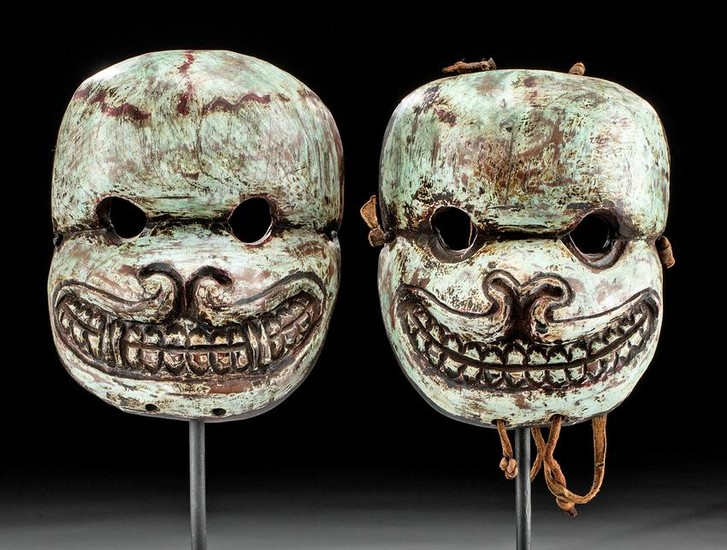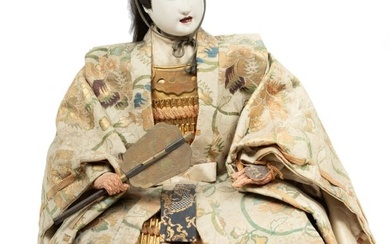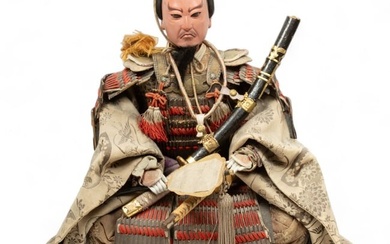Lot of 2 Early 20th C. Tibetan Wood Citipati Masks
Central Asia, Tibet, ca. early to mid 20th century CE. A fierce pair of carved wooden masks, each depicting the face of a Citipati, a skeletal protector deity in Tibetan Buddhism. Each has a leering, skull-like countenance, including a opening for the nose, wide, sunken eyes, and a huge, toothy grin. Each is painted pale green, with black in the lower profile areas and red around the forehead (more visible on one than the other). They have subtle differences of form - one has spiral-shaped nostrils, while the other has wider openings, and one has sharp canine teeth, while the other's teeth are uniform - inviting the viewer to look more closely for further study. The back of each is polished and unpainted. Leather straps remaining on one give an idea of how they could be worn. Size of one (they are nearly identical): 5.35" W x 7" H (13.6 cm x 17.8 cm); 12" H (30.5 cm) on included custom stand.
Despite their overall frightening appearance, the Citipati protect the Dharma (Buddhist teachings) from forces of dejection and ignorance. The Citipati are worldly guardians, each with a third eye of wisdom. Typically depicted in pairs, the skeletons or Citipati (also known as Chitipati) represent a pair of lovers known as the Lord and Lady of the funeral pyre, whose sacred skeleton dance symbolizes the eternal dance of death as well as the arrival at absolute consciousness. In the traditional performance of the Tibetan Skeleton dance at cemeteries, the two Dharmapalas (Protectors of Truth) are played by Monks. They are deities whose primary role is to protect the cemetery grounds. Beyond this, their presence signifies the ephemeral nature of this earthly world and reminds the audience members of their own mortality. The cult of the Second Buddha, Padmasambhava, planted the seed for this practice through their rich mythological literature.
Provenance: private northern California, USA collection; ex-Steve Brothers collection, Nepal
All items legal to buy/sell under U.S. Statute covering cultural patrimony Code 2600, CHAPTER 14, and are guaranteed to be as described or your money back.
A Certificate of Authenticity will accompany all winning bids.
We ship worldwide to most countries and handle all shipping in-house for your convenience.
#153378
Condition Report: Both are in nice condition with no repairs. One has most pigment remaining than the other, notably on the forehead. Only one still has its leather straps for wearing. Light wear on both commensurate with age.
View it on
Estimate
Time, Location
Auction House
Central Asia, Tibet, ca. early to mid 20th century CE. A fierce pair of carved wooden masks, each depicting the face of a Citipati, a skeletal protector deity in Tibetan Buddhism. Each has a leering, skull-like countenance, including a opening for the nose, wide, sunken eyes, and a huge, toothy grin. Each is painted pale green, with black in the lower profile areas and red around the forehead (more visible on one than the other). They have subtle differences of form - one has spiral-shaped nostrils, while the other has wider openings, and one has sharp canine teeth, while the other's teeth are uniform - inviting the viewer to look more closely for further study. The back of each is polished and unpainted. Leather straps remaining on one give an idea of how they could be worn. Size of one (they are nearly identical): 5.35" W x 7" H (13.6 cm x 17.8 cm); 12" H (30.5 cm) on included custom stand.
Despite their overall frightening appearance, the Citipati protect the Dharma (Buddhist teachings) from forces of dejection and ignorance. The Citipati are worldly guardians, each with a third eye of wisdom. Typically depicted in pairs, the skeletons or Citipati (also known as Chitipati) represent a pair of lovers known as the Lord and Lady of the funeral pyre, whose sacred skeleton dance symbolizes the eternal dance of death as well as the arrival at absolute consciousness. In the traditional performance of the Tibetan Skeleton dance at cemeteries, the two Dharmapalas (Protectors of Truth) are played by Monks. They are deities whose primary role is to protect the cemetery grounds. Beyond this, their presence signifies the ephemeral nature of this earthly world and reminds the audience members of their own mortality. The cult of the Second Buddha, Padmasambhava, planted the seed for this practice through their rich mythological literature.
Provenance: private northern California, USA collection; ex-Steve Brothers collection, Nepal
All items legal to buy/sell under U.S. Statute covering cultural patrimony Code 2600, CHAPTER 14, and are guaranteed to be as described or your money back.
A Certificate of Authenticity will accompany all winning bids.
We ship worldwide to most countries and handle all shipping in-house for your convenience.
#153378
Condition Report: Both are in nice condition with no repairs. One has most pigment remaining than the other, notably on the forehead. Only one still has its leather straps for wearing. Light wear on both commensurate with age.







